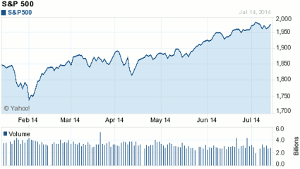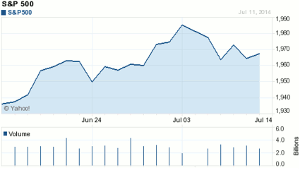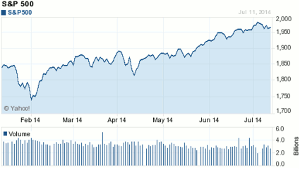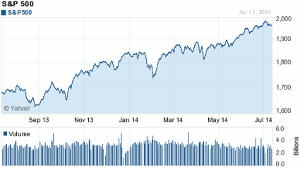David Moenning of StateoftheMarkets.com discusses the market's driving forces and points out the market indicators he's deemed the most important as well as which trends to watch as we move through earnings season.
After more than a week of very little in the way of news to work with, traders were bombarded with inputs Tuesday morning.
In Europe, the all-important ZEW economic surveys showed that the outlook for the economies of Germany and the Euro zone continues to fade. In Germany, the index fell to 27.1 from 29.8 last month and the Euro zone reading was 61.8, which was below the consensus for 62.3. This, coupled with the ongoing banking concern, had the major market indices moving down in afternoon trade across the pond.
Here at home, traders were focused on both the data and some very big name earnings reports. JPMorgan Chase (JPM) and Goldman Sachs (GS) both blew away EPS and revenue estimates and the report from Johnson & Johnson (JNJ) was also above analyst expectations.
In economic news, the Empire Manufacturing Index was strong. The survey of businesses in the New York region showed that business conditions improved significantly for a third consecutive month as the index moved to its highest level in four years. Next, Retail Sales were disappointing again as the June headline came in at +0.2% versus expectations for +0.6%. However, May's level was revised to +0.5% from +0.3%.
Also note that Janet Yellen provided her semi-annual testimony on Capitol Hill Tuesday and Wednesday.
US stock futures were up fractionally and pointed to a mixed open on Wall Street on Wednesday.
Current Market Outlook
The question of the day is if the upbeat state of the earnings season-which, so far, at least, seems to be going swimmingly-can overcome the concerns about Europe's economic slowdown, the issues with Portugal's Banco Espirito Santo, and the geopolitical problems seen in Ukraine, Iraq, and Gaza. The crosswinds in the market explain the fact that the major indices have not been able to break to new highs. However, both the Dow and S&P 500 (SPX) remain only a whisker away from the Promised Land. Putting emotions aside, it is important to note that our market environment models are sagging at the present time, which is not something that usually happens in strong uptrends. But for now, the readings are moderately positive.
Looking at the charts...
This continues to be a tale of two tapes as the blue chip indices (Dow and S&P 500) are currently on the verge of breaking out to fresh all time highs, while the charts of the small-cap and mid-cap indices appear to be in clear downtrends. In addition, if one looks at the weekly charts of the Russell 2000 index (IWM), it appears that a double top formation may be in play. And while the divergences-such as we're seeing now-can persist for some time and are not, in and of themselves, bull killers, strong markets do not usually display this type of action. We will continue to watch the important support zones in the mid-cap and small-cap indices. The bulls don't need the smallcaps to be at new highs in order to proceed. However, the overall market is unlikely to be able to advance if the troops are breaking down to fresh lows.
Pre-Game Indicators
Here are the Pre-Market indicators we review each morning before the opening bell...
Major Foreign Markets:
- Japan: +0.64%
- Hong Kong: +0.49%
- Shanghai: +0.16%
- London: -0.10%
- Germany: -0.16%
- France: -0.32%
- Italy: -0.67%
- Spain: -0.94%
Crude Oil Futures: -$0.66 to $100.25
Gold: +$4.10 at $1310.30
Dollar: lower against the yen, euro, and pound.
10-Year Bond Yield: Currently trading at 2.545%
Stock Futures Ahead of Open in U.S. (relative to fair value):
- S&P 500: +2.35
- Dow Jones Industrial Average: +26
- NASDAQ Composite: +5.14
NEXT PAGE: What Are the Driving Forces?
|pagebreak|Current Market Drivers
We strive to identify the driving forces behind the market action on a daily basis. The thinking is that if we can both identify and understand why stocks are doing what they are doing on a short-term basis, we are not likely to be surprised/blind-sided by a big move. Listed below are what we believe to be the driving forces of the current market (Listed in order of importance).
1. The Outlook for US Economic Growth
2. The State of the Earnings Season
3. The State of Fed/ECB Policy
4. The State of the Geopolitical 'Issues' in Ukraine, Iraq, and Gaza
The State of the Trend
We believe it is important to analyze the market using multiple timeframes. We define short-term as three days to three weeks, intermediate-term as three weeks to three months, and long-term as three months or more. Below are our current ratings of the three primary trends:
Short-Term Trend: High Neutral
(Chart below is S&P 500 daily over past 1 month)
Intermediate-Term Trend: Positive
(Chart below is S&P 500 daily over past 6 months)
Long-Term Trend: Positive
(Chart below is S&P 500 daily over past 12 months)
Key Technical Areas:
Traders as well as computerized algorithms are generally keenly aware of the important technical levels on the charts from a short-term basis. Below are the levels we deem important to watch today:
Key Near-Term Support Zone(s) for S&P 500: 1960(ish)
Key Near-Term Resistance Zone(s): 1985
The State of the Tape
Momentum indicators are designed to tell us about the technical health of a trend-i.e. if there is any "oomph" behind the move. Below are a handful of our favorite indicators relating to the market's "mo"...
Trend and Breadth Confirmation Indicator (Short-Term): Neutral
Signal Explained: History shows the most reliable market moves tend to occur when the breadth indices are in gear with the major market averages. When the breadth measures diverge, investors should take note that a trend reversal may be at hand. This indicator incorporates an All-Cap Dollar Weighted Equity Series and A/D Line. From 1998, when the A/D line is above its 5-day smoothing and the All-Cap Equal Weighted Equity Series is above its 25-day smoothing, the equity index has gained at a rate of +32.5% per year. When one of the indicators is above its smoothing, the equity index has gained at a rate of +13.3% per year. And when both are below, the equity index has lost +23.6% per year.
Price Thrust Indicator: Neutral
Indicator Explained: This indicator measures the 3-day rate of change of the Value Line Composite relative to the standard deviation of the 30-day average. When the Value Line's 3-day rate of change have moved above 0.5 standard deviation of the 30-day average ROC, a thrust occurs and since 2000, the Value Line Composite has gained ground at a rate of +20.6% per year. When the indicator is below 0.5 standard deviation of the 30-day, the Value Line has lost ground at a rate of -10.0% per year. And when neutral, the Value Line has gained at a rate of +5.9% per year.
NEXT PAGE: The Other Market Indicators
|pagebreak|Volume Thrust Indicator: Negative
Indicator Explained: This indicator uses NASDAQ volume data to indicate bullish and bearish conditions for the NASDAQ Composite Index (NYA). The indicator plots the ratio of the 10-day total of NASDAQ daily advancing volume (i.e., the total volume traded in stocks which rose in price each day) to the 10-day total of daily declining volume (volume traded in stocks which fell each day). This ratio indicates when advancing stocks are attracting the majority of the volume (readings above 1.0) and when declining stocks are seeing the heaviest trading (readings below 1.0). This indicator thus supports the case that a rising market supported by heavier volume in the advancing issues tends to be the most bullish condition, while a declining market with downside volume dominating confirms bearish conditions. When in a positive mode, the NASDAQ Composite has gained at a rate of +38.3% per year, when neutral, the NASDAQ has gained at a rate of +13.3% per year. And when negative, the NASDAQ has lost at a rate of -8.5% per year.
Breadth Thrust Indicator: Neutral
Indicator Explained: This indicator uses the number of NASDAQ-listed stocks advancing and declining to indicate bullish or bearish breadth conditions for the NASDAQ Composite. The indicator plots the ratio of the 10-day total of the number of stocks rising on the NASDAQ each day to the 10-day total of the number of stocks declining each day. Using 10-day totals, smooths the random daily fluctuations and gives indications on an intermediate-term basis. As expected, the NASDAQ Composite performs much better when the 10-day A/D ratio is high (strong breadth) and worse when the indicator is in its lower mode (weak breadth). The most bullish conditions for the NASDAQ when the 10-day A/D indicator is not only high, but has recently posted an extreme high reading and thus indicated a thrust of upside momentum. Bearish conditions are confirmed when the indicator is low and has recently signaled a downside breadth thrust. In positive mode, the NASDAQ has gained at a rate of +22.1% per year since 1981. In a neutral mode, the NASDAQ has gained at a rate of +14.5% per year. And when in a negative mode, the NASDAQ has lost at a rate of -6.4% per year.
Bull/Bear Volume Relationship: Moderately Positive
Indicator Explained: This indicator plots both supply and demand volume lines. When the Demand Volume line is above the Supply Volume line, the indicator is bullish. From 1981, the stock market has gained at an average annual rate of +11.7% per year when in a bullish mode. When the Demand Volume line is below the Supply Volume line, the indicator is bearish. When the indicator has been bearish, the market has lost ground at a rate of -6.1% per year.
Technical Health of 100 Industry Groups: Moderately Positive
Model Explained: Designed to provide a reading on the technical health of the overall market, this indicator takes the technical temperature of more than 100 industry sectors each week. Looking back to early 1980, when the model is rated as positive, the S&P has averaged returns in excess of 23% per year. When the model carries a neutral reading, the S&P has returned over 11% per year. But when the model is rated negative, stocks fall by more than -13% a year on average.
The Early Warning Indicators
Markets travel in cycles. Thus we must constantly be on the lookout for changes in the direction of the trend. Looking at market sentiment and the overbought/sold conditions can provide early warning signs that a trend change may be near.
S&P 500 Overbought/Oversold Conditions:
- Short-Term: Neutral
- Intermediate-Term: Moderately Overbought.
Market Sentiment: Our primary sentiment model is Negative.
By David Moenning of StateoftheMarkets.com

























